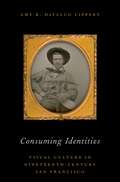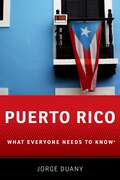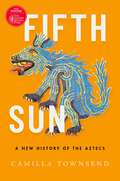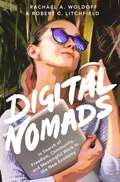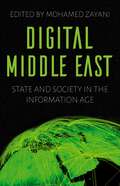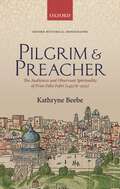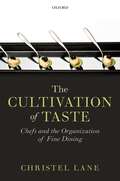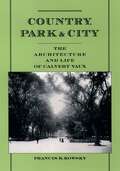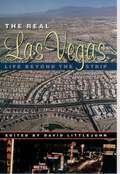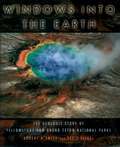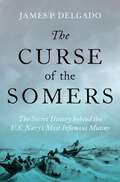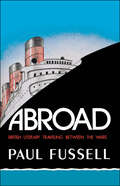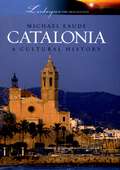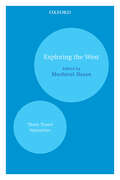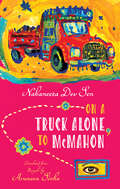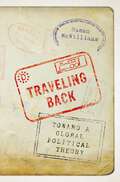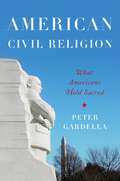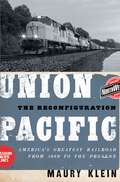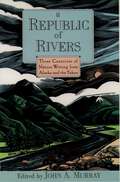- Table View
- List View
Consuming Identities: Visual Culture in Nineteenth-Century San Francisco
by Amy DeFalco LippertAlong with the rapid expansion of the market economy and industrial production methods, such innovations as photography, lithography, and steam printing created a pictorial revolution in nineteenth-century society. The proliferation of visual prints, ephemera, spectacles, and technologies transformed public values and perceptions, and its legacy was as significant as the print revolution that preceded it. Consuming Identities explores the significance of the pictorial revolution in one of its vanguard cities: San Francisco, the revolving door of the gold rush. In their correspondence, diaries, portraits, and reminiscences, thousands of migrants to the city by the Bay demonstrated that visual media constituted a central means by which people navigated the bewildering host of changes taking hold around them in the second half of the nineteenth century, from the spread of capitalism and class formation to immigration and urbanization. Images themselves were inextricably associated with these world-changing forces; they were commodities, but as representations of people, they also possessed special cultural qualities that gave them new meaning and significance. Visual media transcended traditional boundaries of language and culture that divided diverse groups within the same urban space. From the 1848 conquest of California and the gold discovery to the disastrous earthquake and fire of 1906, San Francisco anticipated broader cultural transformations in the commodification, implementation, and popularity of images. For the city's inhabitants and sojourners, an array of imagery came to mediate, intersect with, and even constitute social interaction in a world where virtual reality was becoming normative.
Consuming Identities: Visual Culture in Nineteenth-Century San Francisco
by Amy DeFalco LippertAlong with the rapid expansion of the market economy and industrial production methods, such innovations as photography, lithography, and steam printing created a pictorial revolution in nineteenth-century society. The proliferation of visual prints, ephemera, spectacles, and technologies transformed public values and perceptions, and its legacy was as significant as the print revolution that preceded it. Consuming Identities explores the significance of the pictorial revolution in one of its vanguard cities: San Francisco, the revolving door of the gold rush. In their correspondence, diaries, portraits, and reminiscences, thousands of migrants to the city by the Bay demonstrated that visual media constituted a central means by which people navigated the bewildering host of changes taking hold around them in the second half of the nineteenth century, from the spread of capitalism and class formation to immigration and urbanization. Images themselves were inextricably associated with these world-changing forces; they were commodities, but as representations of people, they also possessed special cultural qualities that gave them new meaning and significance. Visual media transcended traditional boundaries of language and culture that divided diverse groups within the same urban space. From the 1848 conquest of California and the gold discovery to the disastrous earthquake and fire of 1906, San Francisco anticipated broader cultural transformations in the commodification, implementation, and popularity of images. For the city's inhabitants and sojourners, an array of imagery came to mediate, intersect with, and even constitute social interaction in a world where virtual reality was becoming normative.
Puerto Rico: What Everyone Needs to Know® (What Everyone Needs To Know®)
by Jorge DuanyAcquired by the United States from Spain in 1898, Puerto Rico has a peculiar status among Latin American and Caribbean countries. As a Commonwealth, the island enjoys limited autonomy over local matters, but the U.S. has dominated it militarily, politically, and economically for much of its recent history. Though they are U.S. citizens, Puerto Ricans do not have their own voting representatives in Congress and cannot vote in presidential elections (although they are able to participate in the primaries). The island's status is a topic of perennial debate, both within and beyond its shores. In recent months its colossal public debt has sparked an economic crisis that has catapulted it onto the national stage and intensified the exodus to the U.S., bringing to the fore many of the unresolved remnants of its colonial history. Puerto Rico: What Everyone Needs to Know® provides a succinct, authoritative introduction to the Island's rich history, culture, politics, and economy. The book begins with a historical overview of Puerto Rico during the Spanish colonial period (1493-1898). It then focuses on the first five decades of the U.S. colonial regime, particularly its efforts to control local, political, and economic institutions as well as to "Americanize" the Island's culture and language. Jorge Duany delves into the demographic, economic, political, and cultural features of contemporary Puerto Rico-the inner workings of the Commonwealth government and the island's relationship to the United States. Lastly, the book explores the massive population displacement that has characterized Puerto Rico since the mid-20th century. Despite their ongoing colonial dilemma, Jorge Duany argues that Puerto Ricans display a strong national identity as a Spanish-speaking, Afro-Hispanic-Caribbean nation. While a popular tourist destination, few beyond its shores are familiar with its complex history and diverse culture. Duany takes on the task of educating readers on the most important facets of the unique, troubled, but much beloved isla del encanto.
PUERTO RICO WENK C: What Everyone Needs to Know® (What Everyone Needs To Know®)
by Jorge DuanyAcquired by the United States from Spain in 1898, Puerto Rico has a peculiar status among Latin American and Caribbean countries. As a Commonwealth, the island enjoys limited autonomy over local matters, but the U.S. has dominated it militarily, politically, and economically for much of its recent history. Though they are U.S. citizens, Puerto Ricans do not have their own voting representatives in Congress and cannot vote in presidential elections (although they are able to participate in the primaries). The island's status is a topic of perennial debate, both within and beyond its shores. In recent months its colossal public debt has sparked an economic crisis that has catapulted it onto the national stage and intensified the exodus to the U.S., bringing to the fore many of the unresolved remnants of its colonial history. Puerto Rico: What Everyone Needs to Know® provides a succinct, authoritative introduction to the Island's rich history, culture, politics, and economy. The book begins with a historical overview of Puerto Rico during the Spanish colonial period (1493-1898). It then focuses on the first five decades of the U.S. colonial regime, particularly its efforts to control local, political, and economic institutions as well as to "Americanize" the Island's culture and language. Jorge Duany delves into the demographic, economic, political, and cultural features of contemporary Puerto Rico-the inner workings of the Commonwealth government and the island's relationship to the United States. Lastly, the book explores the massive population displacement that has characterized Puerto Rico since the mid-20th century. Despite their ongoing colonial dilemma, Jorge Duany argues that Puerto Ricans display a strong national identity as a Spanish-speaking, Afro-Hispanic-Caribbean nation. While a popular tourist destination, few beyond its shores are familiar with its complex history and diverse culture. Duany takes on the task of educating readers on the most important facets of the unique, troubled, but much beloved isla del encanto.
Fifth Sun: A New History of the Aztecs
by Camilla TownsendIn November 1519, Hernando Cortés walked along a causeway leading to the capital of the Aztec kingdom and came face to face with Moctezuma. That story--and the story of what happened afterwards--has been told many times, but always following the narrative offered by the Spaniards. After all, we have been taught, it was the Europeans who held the pens. But the Native Americans were intrigued by the Roman alphabet and, unbeknownst to the newcomers, they used it to write detailed histories in their own language of Nahuatl. Until recently, these sources remained obscure, only partially translated, and rarely consulted by scholars. For the first time, in Fifth Sun, the history of the Aztecs is offered in all its complexity based solely on the texts written by the indigenous people themselves. Camilla Townsend presents an accessible and humanized depiction of these native Mexicans, rather than seeing them as the exotic, bloody figures of European stereotypes. The conquest, in this work, is neither an apocalyptic moment, nor an origin story launching Mexicans into existence. The Mexica people had a history of their own long before the Europeans arrived and did not simply capitulate to Spanish culture and colonization. Instead, they realigned their political allegiances, accommodated new obligations, adopted new technologies, and endured. This engaging revisionist history of the Aztecs, told through their own words, explores the experience of a once-powerful people facing the trauma of conquest and finding ways to survive, offering an empathetic interpretation for experts and non-specialists alike.
Fifth Sun: A New History of the Aztecs
by Camilla TownsendIn November 1519, Hernando Cortés walked along a causeway leading to the capital of the Aztec kingdom and came face to face with Moctezuma. That story--and the story of what happened afterwards--has been told many times, but always following the narrative offered by the Spaniards. After all, we have been taught, it was the Europeans who held the pens. But the Native Americans were intrigued by the Roman alphabet and, unbeknownst to the newcomers, they used it to write detailed histories in their own language of Nahuatl. Until recently, these sources remained obscure, only partially translated, and rarely consulted by scholars. For the first time, in Fifth Sun, the history of the Aztecs is offered in all its complexity based solely on the texts written by the indigenous people themselves. Camilla Townsend presents an accessible and humanized depiction of these native Mexicans, rather than seeing them as the exotic, bloody figures of European stereotypes. The conquest, in this work, is neither an apocalyptic moment, nor an origin story launching Mexicans into existence. The Mexica people had a history of their own long before the Europeans arrived and did not simply capitulate to Spanish culture and colonization. Instead, they realigned their political allegiances, accommodated new obligations, adopted new technologies, and endured. This engaging revisionist history of the Aztecs, told through their own words, explores the experience of a once-powerful people facing the trauma of conquest and finding ways to survive, offering an empathetic interpretation for experts and non-specialists alike.
Digital Nomads: In Search of Freedom, Community, and Meaningful Work in the New Economy
by Rachael A. Woldoff Robert C. LitchfieldA small but growing group of today's knowledge workers actively seek a lifestyle of freedom, using technology to perform their jobs, traveling far and wide, and moving as often as they like. These digital nomads have left their local coffee shops behind and now proudly post their "office of the day" photos from exotic locales, but what do their lives really look like? In Digital Nomads, Rachael Woldoff and Robert Litchfield take readers into an expatriate digital nomad community in Bali, Indonesia to better understand this growing demographic of typically Millennial workers. Through dozens of interviews and several stints living in a digital nomad hub, Woldoff and Litchfield present new answers to classic questions about community, creativity, and work. They further show why digital nomads leave their conventional lives behind, arguing that creative class and Millennial workers, though successful, often feel that their "world class cities" and desirable jobs are anything but paradise. They first follow their transitions into freelancing, entrepreneurship, and remote work, then explain how digital nomads create a fluid but intimate community abroad in the company of like-minded others. Ultimately, Woldoff and Litchfield provide insight into digital nomads' efforts to live and work in ways that balance freedom, community, and creative fulfillment in the digital age. A sympathetic yet critical take on this emerging group of workers, Digital Nomads provides a revealing take on the changing nature of work and the problems of the new economy.
Digital Nomads: In Search of Freedom, Community, and Meaningful Work in the New Economy
by Rachael A. Woldoff Robert C. LitchfieldA small but growing group of today's knowledge workers actively seek a lifestyle of freedom, using technology to perform their jobs, traveling far and wide, and moving as often as they like. These digital nomads have left their local coffee shops behind and now proudly post their "office of the day" photos from exotic locales, but what do their lives really look like? In Digital Nomads, Rachael Woldoff and Robert Litchfield take readers into an expatriate digital nomad community in Bali, Indonesia to better understand this growing demographic of typically Millennial workers. Through dozens of interviews and several stints living in a digital nomad hub, Woldoff and Litchfield present new answers to classic questions about community, creativity, and work. They further show why digital nomads leave their conventional lives behind, arguing that creative class and Millennial workers, though successful, often feel that their "world class cities" and desirable jobs are anything but paradise. They first follow their transitions into freelancing, entrepreneurship, and remote work, then explain how digital nomads create a fluid but intimate community abroad in the company of like-minded others. Ultimately, Woldoff and Litchfield provide insight into digital nomads' efforts to live and work in ways that balance freedom, community, and creative fulfillment in the digital age. A sympathetic yet critical take on this emerging group of workers, Digital Nomads provides a revealing take on the changing nature of work and the problems of the new economy.
Digital Middle East: State and Society in the Information Age
In recent years, the Middle East's information and communications landscape has changed dramatically. Increasingly, states, businesses, and citizens are capitalizing on the opportunities offered by new information technologies, the fast pace of digitization, and enhanced connectivity. These changes are far from turning Middle Eastern nations into network societies, but their impact is significant. The growing adoption of a wide variety of information technologies and new media platforms in everyday life has given rise to complex dynamics that beg for a better understanding. Digital Middle East sheds a critical light on continuing changes that are closely intertwined with the adoption of information and communication technologies in the region. Drawing on case studies from throughout the Middle East, the contributors explore how these digital transformations are playing out in the social, cultural, political, and economic spheres, exposing the various disjunctions and discordances that have marked the advent of the digital Middle East.
Digital Middle East: State and Society in the Information Age
by Mohamed ZayaniIn recent years, the Middle East's information and communications landscape has changed dramatically. Increasingly, states, businesses, and citizens are capitalizing on the opportunities offered by new information technologies, the fast pace of digitization, and enhanced connectivity. These changes are far from turning Middle Eastern nations into network societies, but their impact is significant. The growing adoption of a wide variety of information technologies and new media platforms in everyday life has given rise to complex dynamics that beg for a better understanding. Digital Middle East sheds a critical light on continuing changes that are closely intertwined with the adoption of information and communication technologies in the region. Drawing on case studies from throughout the Middle East, the contributors explore how these digital transformations are playing out in the social, cultural, political, and economic spheres, exposing the various disjunctions and discordances that have marked the advent of the digital Middle East.
Pilgrim And Preacher: The Audiences And Observant Spirituality Of Friar Felix Fabri (1437/8-1502) (Oxford Historical Monographs)
by Kathryne BeebePilgrim and Preacher seeks to understand the numerous pilgrimage writings of the Dominican Felix Fabri (1437/8-1502), not only as rich descriptions of the Holy Land, Egypt, and Palestine, but also as sources for the religious attitudes and social assumptions that went into their creation. Fabri, an Observant reformer and talented preacher, as well as a two-time Holy Land pilgrim, adapted his pilgrimage experiences for four different audiences. He produced the rhymed Swabian-German Pilgerbüchlein for those who sponsored his first voyage; the encyclopaedic Latin Evagatorium for his Dominican brethren; the vernacular Pilgerbuch for the noble patrons of his second voyage and their households; and finally, the vernacular Sionpilger-an 'imagined' or 'virtual' pilgrimage - for the nuns in his care, who were unable to make the real journey themselves. This study asks fundamental questions about the readership for such works, and then builds upon an analysis of Fabri's audiences to reassess the nature of piety, and the place both pilgrimage literature and Observant reform had in it, in late-medieval Germany. Pilgrim and Preacher is a study of reception, yet one that departs from traditional approaches to pilgrimage literature, which see pilgrimage writing merely as a body of texts to be classified according to genre or mined for colourful details about the Jerusalem journey. This work combines the insights of both literary theory and historical studies with an original, empirical contribution based on an analysis of the manuscripts and printed history of Fabri's writings, setting them in their historical and cultural contexts. Such an analysis allows us to understand better the working of the religious imagination amongst urban elites and women religious in the late middle ages. By charting the influences of the Observance Movement within the Dominican, Fabri's writings were intended for both his young novices (to make them more effective preachers) and for the religious women who could only go to Jerusalem via the imagination, Pilgrim and Preacher also makes an important contribution to the history of the Dominican Observance movement and the wider currents that flowed between it and the civic and religious feelings of the age.
The Cultivation Of Taste: Chefs And The Organization Of Fine Dining
by Christel LaneAfter many decades, if not centuries, of neglect of fine food and high-level restaurants in Britain, we are seeing a massive explosion of interest in food, cooking, and dining out. Christel Lane's book charts the process of this transformation and examines top contemporary restaurants and their chefs. The Cultivation of Taste presents a comparative study of Michelin-starred restaurants in Britain and Germany, focusing on two countries without an indigenous haute cuisine but which nevertheless have developed internationally reputed fine-dining sectors, and comparing their development to the fine-dining culture in France. Written from a sociological perspective, chefs are portrayed as part of a complex network, in their relationships with their employees, their customers, gastronomic critics, suppliers of food, and even their financiers. It will appeal to academics in the areas of economic and cultural sociology, and those with an interest in small entrepreneurial firms and their work relations, but also to all those who have an interest in fine-dining restaurants and the chef patrons at the centre of them. The book draws on a large number of interviews with renowned chefs, diners, and Michelin inspectors to provide an unprecedented insight into what goes on in Michelin-starred restaurants—what makes their chefs tick, intrigues their critics, and beguiles or annoys their customers. Restaurants are viewed not simply as businesses but as cultural enterprises that shape our taste in food, ambience, and sociality.
Country, Park And City: The Architecture And Life Of Calvert Vaux
by Francis R. KowskyAfter beginning his architectural career in England, Calvert Vaux came to America in 1850 at the invitation of architect Andrew Jackson Downing. In 1852, he moved to New York City and asked Frederick Law Olmsted, the landscape architect, to join him in preparing a design for Central Park.During the next thirty-eight years in New York, Vaux defended and refined his vision of Central Park and pursued a distinguished architectural practice. After the Civil War, he and Olmsted led the nascent American park movement with their designs for parks in many American cities. And as apioneering advocate for apartment houses in American cities, Vaux designed buildings that mirrored the advance of urbanization in America, including early model-housing for the poor. His works also include many Gothic and Palladian style dwellings, the original portions of the Metropolitan Museum ofArt and the American Museum of Natural History, and a stunning proposal for a vast iron and glass building to house the Centennial Exhibition in Philadelphia. Most notable, perhaps, are the many bridges and other structures that he designed for Central Park. This book is the first in-depth study ofVaux's life and work.
The Real Las Vegas: Life Beyond the Strip
by Eric GranWhat images come to mind when you think of Las Vegas? Mobsters and showgirls, magicians and tigers, multimillion-dollar poker games and prizefights; towering signboards that light up the night in front of ever more spectacular casino hotels. But real people live here, too--over a million today, two million tomorrow. Greater Las Vegas has long been the fastest growing metropolitan area in America. And almost every aspect of its citizens' lives is influenced by the almighty power of the gambling industry. A team of fifteen reporters led by David Littlejohn, together with prize winning photo-journalist Eric Gran, studied the "real" Las Vegas--the city beyond the Strip and Downtown--for the better part of a year. They talked to teenagers (whose suicide and dropout rates frighten parents), senior citizens (many of whom spend their days playing bingo and the slots), Mexican immigrants (who build the new houses and clean the hotels), homeless people and angry blacks, as well as local police, active Christians, city officials, and prostitutes. They looked into the local churches, the powerful labor unions, pawn shops, the real estate boom, defiant ranchers to the north, and dire predictions that the city is about to run out of water. Proud Las Vegans claim that theirs is just a friendly southwestern boomtown--"the finest community I have ever lived in," says Bishop Daniel Walsh, who comes from San Francisco. But their picture of Las Vegas as a vibrant, civic-minded metropolis conflicts with evidence of transiency, rootlessness, political impotence, and social dysfunction. In this close-up investigation of the real lives being led in America's most tourist-jammed, gambling-driven city, readers will discover a Las Vegas very different from the one they may have seen or imagined.
Windows into the Earth: The Geologic Story of Yellowstone and Grand Teton National Parks
by Robert B. Smith Lee J. SiegelMillions of years ago, the North American continent was dragged over the world's largest continental hotspot, a huge column of hot and molten rock rising from the Earth's interior that traced a 50-mile wide, 500-mile-long path northeastward across Idaho. Generating cataclysmic volcanic eruptions and large earthquakes, the hotspot helped lift the Yellowstone Plateau to more than 7,000 feet and pushed the northern Rockies to new heights, forming unusually large glaciers to carve the landscape. It also created the jewel of the U.S. national park system: Yellowstone. Meanwhile, forces stretching apart the western U.S. created the mountainous glory of Grand Teton National Park. These two parks, with their majestic mountains, dazzling geysers, and picturesque hot springs, are windows into the Earth's interior, revealing the violent power of the dynamic processes within. Smith and Siegel offer expert guidance through this awe-inspiring terrain, bringing to life the grandeur of these geologic phenomena as they reveal the forces that have shaped--and continue to shape--the greater Yellowstone-Teton region. Over seventy illustrations--including fifty-two in full color--illuminate the breathtaking beauty of the landscape, while two final chapters provide driving tours of the parks to help visitors enjoy and understand the regions wonders. Fascinating and informative, this book affords us a striking new perspective on Earth's creative forces.
The Curse of the Somers: The Secret History behind the U.S. Navy's Most Infamous Mutiny
by James P. DelgadoA detailed and riveting account of the U.S. Navy's greatest mutiny and its wide-ranging cultural and historical impact The greatest controversy in the history of the U.S. Navy of the early American Republic was the revelation that the son of the Secretary of War had seemingly plotted a bloody mutiny that would have turned the U.S. brig Somers into a pirate ship. The plot discovered, he and his co-conspirators were hastily condemned and hanged at sea. The repercussions of those acts brought headlines, scandal, a fistfight at a cabinet meeting, a court martial, ruined lives, lost reputations, and tales of a haunted ship "bound for the devil" and lost tragically at sea with many of its crew. The "Somers affair" led to the founding of the U.S. Naval Academy and it remains the Navy's only acknowledged mutiny in its history. The story also inspired Herman Melville's White-Jacket and Billy Budd. Others connected to the Somers included Commodore Perry, a relation and defender of the Somers' captain Mackenzie; James Fenimore Cooper, whose feud with the captain, dating back to the War of 1812, resurfaced in his reportage of the affair; and Raphael Semmes, the Somers' last caption who later served in the Confederate Navy. The Curse of the Somers is a thorough recreation of this classic tale, told with the help of recently uncovered evidence. Written by a maritime historian and archaeologist who helped identify the long-lost wreck and subsequently studied its sunken remains, this is a timeless tale of life and death at sea. James P. Delgado re-examines the circumstances, drawing from a rich historical record and from the investigation of the ship's sunken remains. What surfaces is an all-too-human tale that resonates and chills across the centuries.
The Curse of the Somers: The Secret History behind the U.S. Navy's Most Infamous Mutiny
by James P. DelgadoA detailed and riveting account of the U.S. Navy's greatest mutiny and its wide-ranging cultural and historical impact The greatest controversy in the history of the U.S. Navy of the early American Republic was the revelation that the son of the Secretary of War had seemingly plotted a bloody mutiny that would have turned the U.S. brig Somers into a pirate ship. The plot discovered, he and his co-conspirators were hastily condemned and hanged at sea. The repercussions of those acts brought headlines, scandal, a fistfight at a cabinet meeting, a court martial, ruined lives, lost reputations, and tales of a haunted ship "bound for the devil" and lost tragically at sea with many of its crew. The "Somers affair" led to the founding of the U.S. Naval Academy and it remains the Navy's only acknowledged mutiny in its history. The story also inspired Herman Melville's White-Jacket and Billy Budd. Others connected to the Somers included Commodore Perry, a relation and defender of the Somers' captain Mackenzie; James Fenimore Cooper, whose feud with the captain, dating back to the War of 1812, resurfaced in his reportage of the affair; and Raphael Semmes, the Somers' last caption who later served in the Confederate Navy. The Curse of the Somers is a thorough recreation of this classic tale, told with the help of recently uncovered evidence. Written by a maritime historian and archaeologist who helped identify the long-lost wreck and subsequently studied its sunken remains, this is a timeless tale of life and death at sea. James P. Delgado re-examines the circumstances, drawing from a rich historical record and from the investigation of the ship's sunken remains. What surfaces is an all-too-human tale that resonates and chills across the centuries.
Abroad: British Literary Traveling between the Wars
by Paul FussellA book about the meaning of travel, about how important the topic has been for writers for two and a half centuries, and about how excellent the literature of travel happened to be in England and America in the 1920s and 30s.
Catalonia: A Cultural History (Landscapes of the Imagination)
by Michael EaudeSqueezed between more powerful France and Spain, Catalonia has endured a violent history. Its medieval empire that conquered Naples, Sicily and Athens was crushed by Spain. Its geography, with the Pyrenees falling sharply to the rugged Costa Brava, is tormented, too. Michael Eaude traces this history and it monuments: roman Tarragona, celebrated by the poet Martial; Greek Empúries, lost for centuries beneath the sands; medieval Romanesque architecture in the Vall de Bo:i churches (a World Heritage Series) and Poblet and Santes Creus monasteries. He tells the stories of several of Catalonia's great figures: Abbot Olivia, who brought Moorish learning to Europe, the ruthless mercenary, Roger de Flor, and Verdaguer, handsome poet-priest. Catalonia is famous today for its twentieth-century art. This book focuses on the revolutionary Art Nouveau buildings (including the Sagrada Família) of Antoni Gaudí. It also explores the region's artistic legacy: the young Picasso painting Barcelona's vibrant slums; Salvador Dalí, inspired by the twisted rocks of Cap de Creus to paint his landscapes of the human mind; and Joan Miró, discovering the colors of the red earth at Montroig.
Exploring the West: Three Travel Narratives
by Mushirul HasanInverting the conventional imagery of Europeans' travel narratives about South Asia, this omnibus brings together three fascinating accounts of Indian interaction with the West. It raises interesting questions about cross-cultural encounters. Is the West objectively perceived and represented? Do observers colour fact with fiction? Do they talk of an East–West divide? The first volume is an account of Itesamuddin's travel (1766–9) to Europe. Set in the context of the grant of Diwani to the British in India, Images of the West, offers fresh insights on the state and everyday life in England discussing questions of religious controversies, military, and law. Its author also gives us a panoramic view of the socio-cultural life, flora and fauna, and education and lifestyles. Abu Taleb's travelogue provides a non-Western representation of the West, sheds light on the national customs and manners of Europeans. Westward Bound, comprises his impressions of England, France, Genoa, Malta, Turkey, and Baghdad during his travels (1799–1803). His understanding of cultural streams in the East and West provide an alternative viewpoint on the encounter between Pax Brittanica and the sharif families of North India. Seamless Boundaries presents the autobiography of Lutfullah Khan, one of the earliest known works by an Indian in English. Traversing geographical and cultural boundaries, Lutfullah's narrative defies conventional labels. He explores events, people, and their culture beyond the mere east–west dichotomies. He also presents a graphic account of his voyage to England in 1844. Mushirul Hasan's introduction explores the life and times of these travellers. Arguing for exploring the West and the Muslim societies from an unsentimental and wide-ranging perspective, he investigates the discourse on East–West relations, and highlights the significance of travel narratives as historical records in the production of knowledge.
On a Truck Alone, to McMahon
by Nabaneeta Dev SenI wasn’t trying to discover new places. I wasn’t going to break or create a record. I was going only on an impulse, entirely my own, just out of the natural curiosity that life brings, the delight of living. Was this not a valid enough reason? With curiosity in her heart and a prayer on her lips, Nabaneeta hauled herself on to a truck and set off on a journey to fill her unfilled bag of stories. Sacks, paper cartons, steel cupboards, wicker furniture, baskets of angry, clucking chickens, and a sharp smell surrounded her. How many days in this stench? How many hours? How many endless moments? This is a travelogue of Nabaneeta’s journey from Jorhat in Assam all the way to the McMahon line at the Indo-Tibetan border, a trip undertaken on an impulse, detailing her encounters with countless ordinary individuals, their reactions to a middle-aged woman’s solo road trip in India in 1977, and the extraordinary events that unfold along the way. Reflective and humorous, the narrative presents travel as an avenue of liberation.
Union Pacific: The Reconfiguration: America's Greatest Railroad from 1969 to the Present
by Maury KleinPraised by the Chicago Tribune as "thoroughly and compellingly detailed history," Volumes I and II of Maury Klein's monumental history of the Union Pacific Railroad covered the years from 1863-1969. Now the third and final volume brings the story of the Union Pacific--the oldest, largest, and most successful railroad of modern times--fully up to date. The book follows the trajectory of an icon of the industrial age trying to negotiate its way in a post-railway world, plagued by setbacks such as labor disputes, aging infrastructure, government de-regulation, ill-fated mergers, and more. By 1969 the same company that a century earlier had triumphantly driven the golden spike into Promontory Summit--to immortalize the nation's first transcontinental railway--seemed a dinosaur destined for financial ruin. But as Klein shows, the Union Pacific not only survived but is once more thriving, which proves that railways remain critical to commerce and industry in America, even as passenger train travel has all but disappeared. Drawing on interviews with Union Pacific personnel past and present, Klein takes readers inside the great railroad--into its boardrooms and along its tracks--to show how the company adapted to the rapidly changing world of modern transportation. The book also offers fascinating portraits of the men who have run the railroad. The challenges they faced, and the strategies they developed to meet them, give readers a rare glimpse into the inner workings of one of America's great companies. A capstone on a remarkable achievement, Union Pacific: The Reconfiguration will appeal to historians, business scholars, and transportation buffs alike.
A Republic of Rivers: Three Centuries of Nature Writing from Alaska and the Yukon
"The spell of Alaska," Ella Higginson wrote in 1908, "falls upon every lover of beauty who has voyaged along those far northern snow-pearled shores...or who has drifted down the mighty rivers of the interior which flow, bell-toned and lonely, to the sea....No writer has ever described Alaska; no one writer ever will; but each must do his share, according to the spell that the country casts upon him." In A Republic of Rivers, John Murray offers the first comprehensive anthology of nature writing in Alaska and the Yukon, ranging from 1741 to the present. Many of the writers found here are major figures--John Muir, Jack London, Annie Dillard, Barry Lopez, and Edward Abbey--but we also discover the voices of missionaries, explorers, mountain-climbers, Native Americans, miners, scientists, backpackers, and fishermen, each trying to capture something of the beauty of this still pristine land, to render in their own words the spell that the country casts upon them. The range of viewpoints is remarkable. With Annie Dillard we look out at ice floes near the remote Barter Island and see "what newborn babies must see: nothing but senseless variations of light on the retinas." With Frederick Litke we mourn the senseless slaughter of sea mammals. We join scientist Adolph Murie, the father of wolf ecology, as he probes the daily life of an East Fork wolf pack. And we listen as Tlingit Indian Johnny Jack relates the difficulty of maintaining a dignified life close to nature at a time of cultural upheaval for his people. Most of these selections have never appeared in any anthology and some entries--particularly those written by early American and Russian explorers--have never been available to general readers. There is laughter here and there is sorrow, but finally there is communion and liberation as generation after generation encounter the unsurpassed beauty and wildness of the Arctic. Taken together, these forty-nine men and women provide a unique portrait of America's final frontier.
